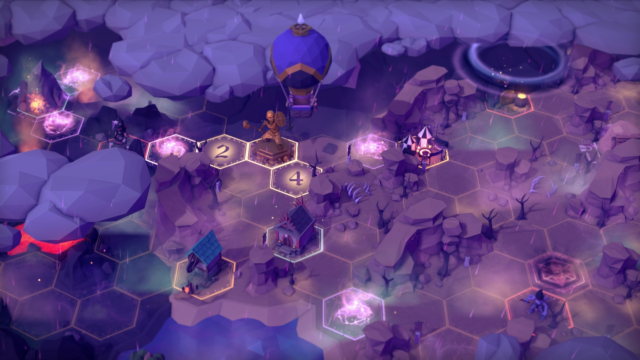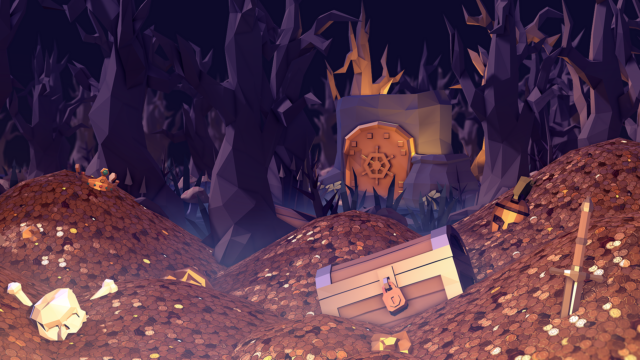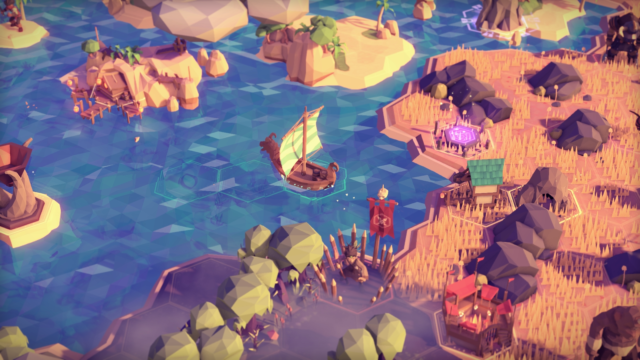Brilliant visual design takes N64-style polygons and does something new and wonderful with them; clever mix of analogue and digital RPG mechanics; use of chance lends some extra strategy to the gameplay; perfectly implemented co-op
Picking a spot to move to on the map is oddly jittery; it can become slightly grating when trying to wipe out a low-level foe and a bad roll extends the battle; not enough options for character customization
For the King has had a long, fascinating trek on its way to Switch. Developer IronOak Games brought the project to Kickstarter back in 2015 and wanted $40,000 in crowdfunding. The campaign ended with over three times the asking price at $133,661 along with a number of stretch goals met. I first got to try the game at GDC in March of 2018 and was quite smitten with what I got to play. Its intoxicating blend of digital and non-digital RPG mechanics, as well as its thoroughly impressive aesthetic, had me anxious to run through the final game. Now, For the King is on Switch in both digital and physical forms and the time has come to see if the wait was worth it!
For the King is an RPG that mixes tabletop and roguelike gameplay elements. The entire game world is procedurally generated, with the map, enemy placement, events, quests, and more all randomly arranged with each playthrough. The narrative, however, is more deliberate, focused on the assassination of the king of Fahrul and the mystery surrounding who did the deed. The realm is consumed by a force dubbed Chaos and the player, whether working alone or with others, must rise to the queen’s challenge to fight against the encroaching darkness. As a procedurally generated title, I was very pleased with how IronOak was able to provide a combo of memorable set pieces with random elements in a way that never felt watered down or unremarkable. It was reminiscent of Dead Cells and its own randomized game world, but with a larger sense of grandeur.

As far as RPGs go, For the King is rooted in a fairly common medieval fantasy setting. There are wizards, hags, trolls, and heroes with spell books and swords to choose from. If that sounds rote, in some ways it is, but it’s what For the King does with these familiar trapping that sets it apart. Unlike many other contemporary games that claim to be retro-inspired, rather than go for a 2D pixel-based graphical style, For the King instead opted to do something new and exciting with the polygonal days of PlayStation and Nintendo 64.
What IronOak has done is blend the trapezoidal look of the 32 and 64-bit era with today’s gorgeous high fidelity textures and lighting. The result is For the King’s vibrant, colorful world, one where hordes of shambling skeletons and marauders and giant insects all look simultaneously bold, detailed, and somewhat abstract. While For the King doesn’t really venture anywhere uncharted in terms of the visual themes and settings it explores, what it does to present these tried and true elements is very innovative. It’s one of my favorite new takes on retro and I desperately hope that IronOak plays with this style more in future games.
IronOak began as a studio back in 2015 with a trio of vets from the game industry. One of them, designer Colby Young, had been working on a tabletop game called Black Gate which drew heavily from the Ultima series for inspiration. What made Black Gate especially unique was how it utilized both digital RPG and analogue board game mechanics. This creative blend was carried over into For the King and it’s a huge part of the title’s allure. Battles play out like a typical JRPG, but what makes everything from fighting to world exploration exciting is the element of chance.
Every action is impacted by the roll of a dice. Whether it’s how many tiles on the hexagonal grid of the overworld can be crossed or how much damage a player will mete out during battle, For the King requires players to roll in order to determine how everything will play out during a given turn. Overall, this game of chance works well in serving to keep the battle sequences feeling fresh. Even against fairly benign enemies there’s the possibility that a spell might go wrong, or a hit could land weaker than the player had hoped, which all proves to up the danger and keep progression from feeling automatic and bland.

If that sounds like the player doesn’t have much instrumentality during fights, in reality that couldn’t be further from the truth. For starters, character classes bring with them their own unique stats that heavily impact how certain attacks will be executed. The higher a character’s strength, for instance, and the higher the percentage will be for him to land a crushing blow with his mallet. Indeed, the weapons themselves also have stats and help contribute to what types of attacks can be launched. Finding the right mix of weapons, character classes, and stats is a hugely engaging and entertaining process.
Further balancing out some of the gamble that battling represents is the presence of Focus. Focus is essentially a means of bolstering the chance of making a successful roll during gameplay. For example, if firing off a piercing shot from an arrow requires three rolls to reach maximum power, Focus can be used to reduce that number down to two rolls, one, or even none. As a battle system, the bulk of it is really well balanced and fun, but I did find it sometimes frustrating to have to depend on these rolls when taking on a low-level baddie on the world map. Battles that should have ended in an instant would sadly drag for a turn or two longer than necessary. That stated, it rarely ever interfered with my enjoyment of the game— the luck of the draw was predominantly a welcome presence.

Enjoying For the King is especially easy to do if played with another person. Co-op is heavily emphasized here and, while it can be played solo (which is still fun), the experience just seems to grow exponentially with even a single companion in tow. Each player can create and customize a character, exchange gear, share money, and much more as they make their way around Fahrul. Playing as a team invites even more strategy into a game already spoiled with it, but it never felt overwhelming. Instead, I got a strong sense of achievement from working with my friend to fight off Chaos and free the land. The co-op even works online, and in my time playing, everything was synched almost exactly between my connection and my friend’s.
The randomization in For the King is enough to make the replay value quite high, but whether bought physically or through the eShop, the game also comes with all previously released expansions. For the King has been out on Steam for a couple of years now, so that’s a lot of extra content to bite into. For the King might lean slightly too much on overused fantasy tropes, but it still manages to squeeze something new and creative out of them. I’m obsessed with how cool the visual design is in For the King, I love taking on its challenges with a friend, and I sincerely hope that there’s more to come from IronOak Games. This is a delightful first outing.




 ShareThis
ShareThis





